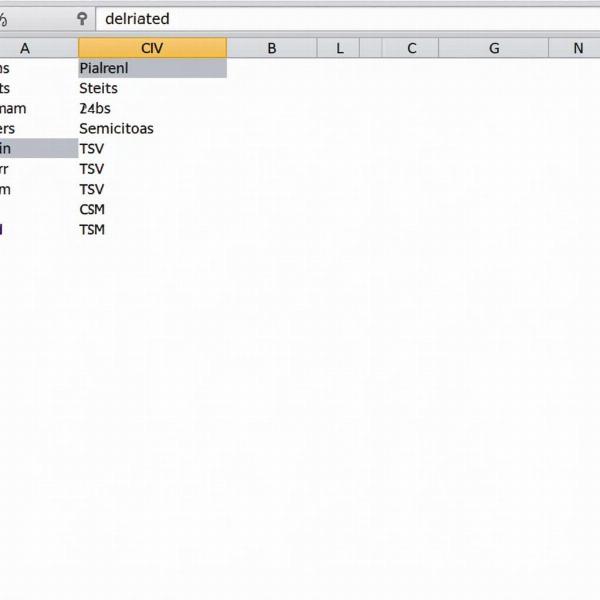Delimited, a word commonly encountered in programming and data processing, essentially means setting boundaries or specifying limits. Understanding its meaning in Hindi can be crucial for anyone working with technology or translating technical documents. This article aims to clarify the meaning of “delimited” in Hindi, explore its various applications, and provide practical examples to solidify your understanding.
Understanding “Delimited” in Hindi
In Hindi, “delimited” can be translated as “सीमांकित” (seemaankit) or “विभाजित” (vibhaajit). Both terms convey the idea of separation or division based on specific boundaries. While “सीमांकित” emphasizes the presence of a boundary, “विभाजित” focuses on the act of division. The most appropriate translation depends on the specific context. For example, when talking about delimited files, “सीमांकित” is generally preferred, while when discussing delimited text, “विभाजित” might be more suitable. Choosing the correct translation ensures accurate communication and avoids confusion. What exactly does it mean to set these boundaries, and how does this concept apply in different scenarios? Let’s delve deeper.
 Delimited Files Example
Delimited Files Example
Delimiters in Action: Practical Examples
Consider a comma-separated value (CSV) file. Here, the comma acts as the delimiter, separating each piece of data within a row. Similarly, in a tab-separated value (TSV) file, the tab character serves as the delimiter. These delimiters are essential for parsing data correctly and organizing it into meaningful structures. Imagine trying to read a large dataset without any delimiters—it would be a chaotic jumble of information!
Other common delimiters include pipes (|), semicolons (;), and even spaces. The choice of delimiter depends on the specific data format and the potential presence of the delimiter within the data itself. For instance, if your data contains commas, using a comma as a delimiter would create ambiguities. In such cases, a less common delimiter like a pipe or semicolon would be a better choice.
Delimited Data in Programming
In programming, delimiters play a crucial role in string manipulation, data parsing, and file processing. They are used to split strings, extract specific data elements, and format output. Many programming languages have built-in functions for working with delimited data, making it easier to process and analyze information. Think of delimiters as the silent organizers behind the scenes, ensuring that data is structured and accessible.
Delimited Meaning in Different Contexts
Beyond files and programming, the concept of delimitation extends to various other fields. In linguistics, delimiters can mark the boundaries between words or phrases. In mathematics, they can define the limits of an equation. Even in everyday life, we use delimiters in language and writing, such as commas, periods, and parentheses, to structure our thoughts and convey meaning effectively.
Delimited vs. Fixed-Width Formats
Delimited files contrast with fixed-width formats, where each data field occupies a predefined number of characters. While delimited files offer flexibility in terms of data length, fixed-width formats maintain strict alignment. Understanding the differences between these formats is crucial for choosing the right one for your needs.
Conclusion
Understanding the meaning of “delimited” in Hindi, whether as “सीमांकित” or “विभाजित”, is essential for effective communication in technical contexts. From data processing to programming, delimiters play a vital role in organizing and interpreting information. By grasping the core concept and exploring its practical applications, you can navigate the world of delimited data with confidence.
FAQ
- What is the most common delimiter? The comma (,) is the most commonly used delimiter.
- Can a space be used as a delimiter? Yes, a space can be a delimiter, but it’s less common due to potential issues with data containing spaces.
- Why are delimiters important in programming? Delimiters enable programmers to easily parse and manipulate strings, extract data, and format output.
- What is the difference between delimited and fixed-width formats? Delimited files use separators between fields, while fixed-width files allocate a fixed number of characters per field.
- How do I choose the right delimiter? Consider the data content and potential conflicts with existing characters within the data.
Connect with Meaning-Hindi.in for Your Translation Needs
Meaning-Hindi.in provides expert translation services, specializing in business, legal, technical, website localization, educational, and specialized content. Our team of language professionals ensures accurate and culturally sensitive translations for your specific needs. Whether you need to translate delimited file formats or any other document, Meaning-Hindi.in is your trusted partner. Contact us today for a free consultation: Email: [email protected], Phone: +91 11-4502-7584. Connect with Meaning-Hindi.in for all your Hindi translation needs.